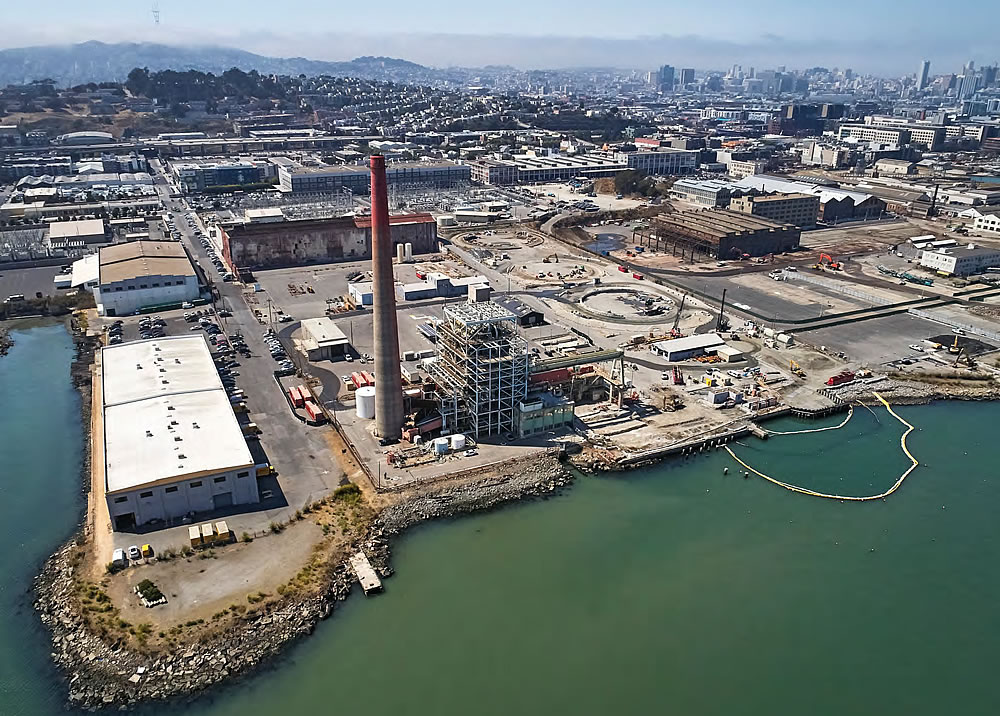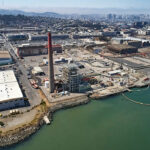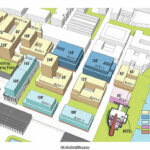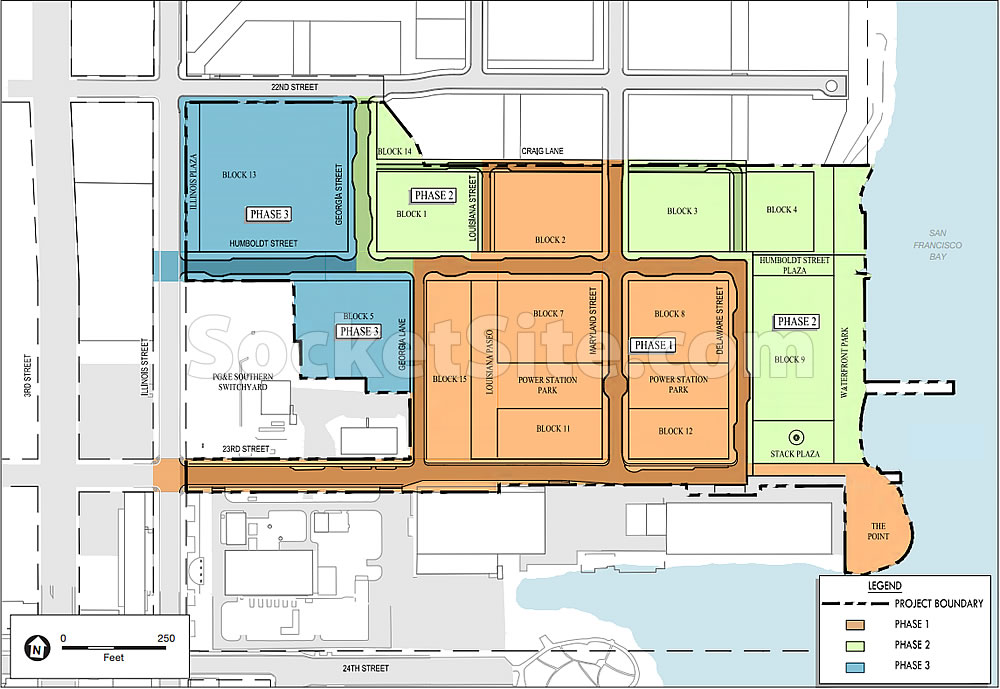Independent of any ongoing impact related to the pandemic or economy in general, the proposed phasing and building timeline for the massive redevelopment of the 29-acre Potrero Power Plant site has been amended and approved.
Rather than building in six phases over the course of 16 years, the team is now planning to develop in three phases, “depending on market conditions,” over the course of the same 16 years, with the first vertical construction of a 435,000-square-foot office building on Block 15 slated to commence in 2023 and be finished in 2026.
Under the revised phasing, as outlined on a block-by-block basis below, the first phase of development would be completed in 2028, with an overlapping second phase running from 2026 through 2031 and the third and final phase of the development wrapping up construction in late 2035 (assuming it commences in 2030).
In addition, the number of residential units to be built across the site has been reduced from a maximum of 2,601 as approved, to a maximum of 2,477 as re-phased, with an additional 17,000 square feet of office space (for a total of 831,606), and 24,000 square feet of less retail space (for a total of 75,239), to be constructed overall.
We’ll keep you posted and plugged-in.





We don’t need any more residences (especially luxury lofts and co-living co-ed coder cubes), nor any more office, R&D, hotel, venue, or retail space. We desperately need PDR and raw, un-manicured, open park space.
Leave Warm Water Cove (aka Tire Beach) alone.
This is false by any objective measure. What you meant to say is “I personally don’t want it built.”
Thank you for the substance-free, ad hominem reply. By “any objective measure,” you must mean soaring residential, office, and retail vacancy rates, and the small percentage of PDR footprint remaining that hasn’t yet been turned into condos or ironically-termed “creative space.” What you meant to say is, “gentrification is my meal ticket, and I don’t give a damn if it hollows out neighborhoods and destroys families.”
That’s not what ad hominem means. You’re literally missing that word in a misguided effort to advance a point that is, in fact, your opinion and in no way an actual… fact. Great work.
Go ahead and cite the percentage of industrial and PDR zoned land that has actually been converted to condos. Of course you can’t because you’re making things up. But let’s not let this overshadow that you’re making a wildly inconsistent argument. On the one hand you claim industry is being destroyed and replaced by housing.then you try to claim simultaneously that this destroys families in a city that still has a massive housing shortage, both in BMR and market rate terms. So in effect your assertion is that housing of any kind destroys neighborhoods and families but so does industry. Just laughably and profoundly contradictory.
And to top it all off you repeatedly claim that anyone who disagrees with your mom fact-based opinions must be making money as a real estate developer or is a “coder kid”. These beliefs are both — you’ll be shocked to hear –wrong.
Your responses make for a compendium of logical fallacies. So many errors, so little time…
You impugned the motivation underlying my argument, which most certainly is ad hominem. Your long-neglected copy of freshman critical thinking should confirm this.
New construction in Mission Bay is largely on railroad easement, Van Ness on former retail/office/mixed use. Apart from a few gas stations, nearly all new construction in the eastern neighborhoods has been on former PDR land. Any cursory walk through those nabes will confirm that empirically, assuming you know them well enough to identify the displaced entity, although it’s easy for those to slip down the memory hole.
“[M]assive housing shortage” are emotionally-laden buzzwords that have been used to ram through hundreds of millions of dollars of projects that will leave a figurative and literal dark shadow over the city for generations. There has never has been a shortage of housing. What there has been is a shortage of affordable housing, due to gentrification, misdevelopment (e.g., Madelon, Cubix, millions of empty sq ft of “creative space”), bubble speculation, Air BnB, foreign capital flight, etc., all fueled by ZIRP and QE infinity, all of which combined to raise property valuers and rents, with countless units left off the primary home and rental markets.
Saying someone is “wrong” is easy but meaningless. If you countered my arguments with facts and logic, your attempt to assuage your cognitive dissonance by attacking the messenger might be more successful.
There is nothing wrong with overbuilding. It means cheaper rents for businesses and homes.
Sure, in the world of armchair philosophers and Econ textbooks where prices adjust instantly to the market clearing level.
But in the real world, the one that this discussion is about, in San Francisco, California, commercial properties can and do sit for years on end with “for lease” signs in the windows and the rents do not adjust downwards during economic downturns, but do adjust upwards when there is an economic expansion. I strongly suggest you take a look around real-world S.F., and look closely at all the unleased, unoccupied commercial property while you reevaluate your market fundamentalist, dogmatic belief system.
…why are they leaving the smoke stack?
Kitsch nostalgia
seems like an earthquake hazard
It survived Loma Prieta.
To remind residents their dream homes are build over a toxic waste dump.
#Word
Odd that they build the office component first. Bet that changes as a flood of sublease and under construction office space comes on the market in the next 2 years plus. Odd too that they increase the office component and reduce the housing component. Don’t be surprised to see that reversed. And don’t be surprised to see ground breaking pushed out several years.
As noted by Planning, “the project site has a long history of industrial land uses, and hazardous materials have been identified in the soil, groundwater, and soil vapor as a result of these previous uses.”
Different parts of the site are in various stages of investigation and remediation, under the oversight of the San Francisco Regional Water Quality Control Board.
And the revised phasing is being driven, in large part, by the ongoing investigation, subsequent remediation, and clearances from the Board.
The first phase isn’t scheduled to start until 2023 with delivery in 2026. Nobody who develops, invests, or makes loans in the commercial real estate world believes that the current adverse market conditions will last indefinitely. The 2000-2001 collapse bottomed around 2003. The 2008-2009 collapse bottomed in mid-2010. Developers and lenders take a longer view.
Again, those were mere market corrections.
This is a global black swan event that has changed everything.
Your idea that we’ll get to “normal” in a year or two is far-fetched. Normal has irrevocably shifted
Too bad the part that will activate Illinois Street, a bike route and the most visible part of the development, is coming last. I don’t understand why big developments build inside-out like that. You would think the value of a partially finished project is higher when everyone doesn’t have to pass by a messy construction site on the way to the office each day.
Every project in SF is “revisited” once approved. The problem is the lacking teeth in development agreements negotiated by the city with any clauses for failure to perform. From the SFMTA to the developers to any big corporation or redevelopment group.
30-40 year timelines for some developments is insane and nobody discusses the traffic congestion and environmental costs of the impacts of construction crews and vehicles adjacency or projects and how some areas are already impacted with little mass transit solutions being developed outside the downtown. Couple it with rising sea water and the plans that already ignore waterfront areas That may increase more rapidly with construction emissions and the lacking movement of some developers (see parkmerced / portrero / sunnydale / treasure island / stonestown / India basin and bay view hunters point / Schlage lock and Brisbane and a host of other projects and you have quite a backlogged concern that SFBOS or Planning and the legal departments and SFMTA will need to address and step up if real housing and solutions are to be built to serve the current needs…. timelines being lengthened May need to be shortened on some projects and the financial wizardry and requirements include clauses for failure to complete and a takeover of projects that lagged to long or ignored other serious traffic indicators (aka Parkmerced) … maybe a buy back of the site.
Agreed. San Francisco as an overseer of anything is now and going forward fixated only on how to pay for an insanely bloated payroll and retirement bill equal to that of entire states. These mega developers (that btw serve primarily as a means for global crooks and oligarchs to park their hoards of stolen money) win out because they pay the ravenous gaping maw of SFGov. If that neighborhood were developed organically with creativity and local architects it could be really special and fully formed in a decade. But nope. Windswept and empty me-too new urbanist banality is what we’ll get, as usual.
UPDATE: The Plans To Transform the Dilapidated Station A [on Block 15] Into an Icon.
UPDATE: Refined Plans for the First Power Station Tower to Rise